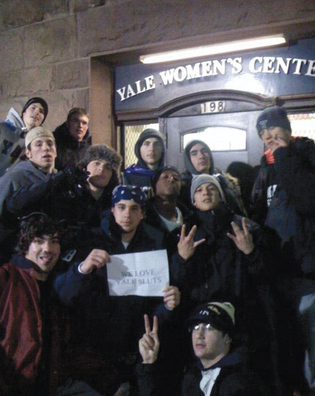 loading
loading
featuresWhat can we say?The fraternity chants that helped launch a federal investigation raise an old question: is it ever right for Yale to suppress or punish speech? Gaddis Smith ’54, ’61PhD, is the Larned Professor Emeritus of History. He is writing a history of Yale in the twentieth century.  A photo of Zeta Psi pledges posing in front of the Women's Center with a sign reading "We Love Yale Sluts," posted online in 2008, is one of several recent incidents detailed in a Title IX complaint against the university. View full image
For decades, Yale has officially proclaimed freedom of expression a value hallowed above all else. But the application of free expression has an uneven history touched with dilemmas. The recent uproar over a group of Delta Kappa Epsilon pledges chanting obscene slogans about rape is just the latest in a series of struggles over speech in the last 50 years. Yale was founded in 1701 on the denial of free expression. Faculty had to swear allegiance to a strict code of Connecticut theology. The only president ever fired was Timothy Cutler (then called rector), found guilty in 1722 of using an Anglican phrase during a commencement service. Well into the twentieth century free expression was circumscribed by presidents and deans. James Rowland Angell, president from 1921 to 1937, believed there were “social values of greater consequence than the license of every lunatic to mount a soapbox and froth at the mouth.” He blocked proposed speakers whose views offended him. Angell retired in 1937. Provost Edgar S. Furniss ’18PhD immediately wrote a landmark memorandum to the new president, Charles Seymour ’08, ’11PhD. Furniss said: [We] have acquired the reputation of being biased in favor of conservative opinion on current public issues, and of using administrative authority to prevent the expression of dissent whenever this takes an advanced liberal or radical form. . . . Such an atmosphere is injurious to morale and prevents the accomplishment of our best in teaching and research. Seymour agreed. He permitted the Communist leader Earl Browder to speak and met alumni criticism by saying the undergraduates were sophisticated enough not to be seduced by nonsense. In 1940, Seymour was an ardent interventionist on the British side in the war against Nazi Germany, but he allowed Charles Lindbergh, the nation’s leading isolationist, to speak before an overflow crowd in Woolsey Hall. Seymour’s successor, A. Whitney Griswold ’29, ’33PhD, was a strong defender of free expression in the face of McCarthyism. Now forward to 1963, when conflict over racial equality and civil rights was bloody. In September, the Yale Political Union invited the white supremacist governor of Alabama, George Wallace, to speak. Just after Wallace accepted, four black girls were killed in the firebombing of a church in Birmingham. Kingman Brewster Jr. ’41, provost and acting president following Griswold’s death the previous April, feared that Wallace’s presence could ignite violence in New Haven. Brewster said that his position “on free speech and on invitations to speakers was uncompromising” but that in this case he had to consider the potential consequences. He told the Political Union to withdraw the invitation. Brewster was roundly criticized. Professor C. Vann Woodward, eminent historian of the American South, said, “The University is in danger of sacrificing principle to expediency. If the South can afford the risk of violence for the principle of Negro rights, New Haven can, too, for the principle of freedom of speech.” Pauli Murray ’65JSD, a courageous foe of racial segregation since the 1930s who would soon be the first black woman to earn a doctorate in law at Yale, argued that “the possibility of violence is not sufficient reason in law to prevent an individual from exercising his constitutional right.” Brewster got the message. Never again did he interfere with an invitation to a speaker. Then came the Shockley crisis. William B. Shockley was an applied physicist at Stanford who had shared a Nobel Prize in 1956 for the development of the electronic transistor. In the 1970s he believed that “scientific” data “proved” the genetic inability of black people to meet the challenges of modern life. He called for voluntary race sterilization—in short, nonviolent self-genocide. A Yale student trio invited Shockley to debate with conservative activist William Rusher whether the federal government should subsidize sterilization. When Shockley appeared on April 15, 1974, he was shouted down by the crowd. Brewster was appalled. He appointed a Committee on Freedom of Expression at Yale under the chairmanship of his critic from 1963, Professor C. Vann Woodward. The committee submitted its report in December 1974. Here is the core: The history of intellectual growth and discovery clearly demonstrates the need for unfettered freedom, the right to think the unthinkable, discuss the unmentionable, and challenge the unchallengeable. . . . If a university is a place for knowledge, it is also a special kind of small society. Yet it is not primarily a fellowship, a club, a circle of friends, a replica of the civil society outside it. Without sacrificing its central purpose, it cannot make its primary and dominant value the fostering of friendship, solidarity, harmony, civility, or mutual respect. The Woodward Report was endorsed by the Yale Corporation. It remains official doctrine to this day. Shockley and Rusher were again invited to debate. They again accepted. This time protesters were urged to boycott the talk and exercise their freedom through leaflets and orderly picketing. The debate was located in Davies Auditorium, a subterranean bunker where no sunlight or noise ever penetrates. The college masters (I was one) and deans were asked to attend and keep the peace. They, some campus police and other officials, the debaters, and the three students who had invited them were alone in an empty auditorium. The debate was boredom on stilts.
|
|